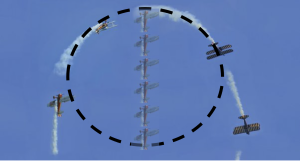56 Practice Makes Perfect VIII
More practice!
Exercise 56.1: Work Review
Two masses ![]() and
and ![]() are connected by a string. They are being pulled up a ramp using a rope. The boxes are accelerating upwards as they are pulled. Draw a force diagram for the forces acting on each of the blocks, and determine:
are connected by a string. They are being pulled up a ramp using a rope. The boxes are accelerating upwards as they are pulled. Draw a force diagram for the forces acting on each of the blocks, and determine:
- Of the forces acting on block 1, which forces do positive work, which do negative work, and which do zero work?
- Of the forces acting on block 2, which forces do positive work, which do negative work, and which do zero work?
- Now consider the two boxes tied by the rope as a single system. Which forces do positive work, which forces do negative work, and which forces do zero work? Is the total work on the system positive or negative?
Exercise 56.2: Colliding Rocks
A rock of mass ![]() is raised to a height
is raised to a height ![]() . A second rock of mass
. A second rock of mass ![]() is raised to a height
is raised to a height ![]() above the first rock. You hold onto the first rock very gently, and let the second rock fall onto the first. The two rocks collide, sticking together. Find how fast the rocks are moving by the time they hit the floor.
above the first rock. You hold onto the first rock very gently, and let the second rock fall onto the first. The two rocks collide, sticking together. Find how fast the rocks are moving by the time they hit the floor.
Before you get started on the picture, make sure you know how many mini-stories there are in this problem, and what the beginning and end of each story is.
Now that you have the story clear in your head, make sure your drawing shows everything it needs to show, including the before and after of each story.
Use your drawing to solve the problem.
Exercise 56.3: Loop-the-loop
The picture below shows a plane doing a loop-the-loop. You can see from the picture that at the top of the loop, the plane is moving in a circle with a diameter that is roughly 5-planes wides. Let’s say the plane is ![]() long. What is the minimum speed that the plane must have at the top of the loop for the pilot to be firmly planted on his chair?
long. What is the minimum speed that the plane must have at the top of the loop for the pilot to be firmly planted on his chair?

To solve this problem, start by making a drawing of the pilot while he is firmly planted on his chair at the top of the loop. Then use the drawing to solve the problem. If needed, use the hint after the picture.
